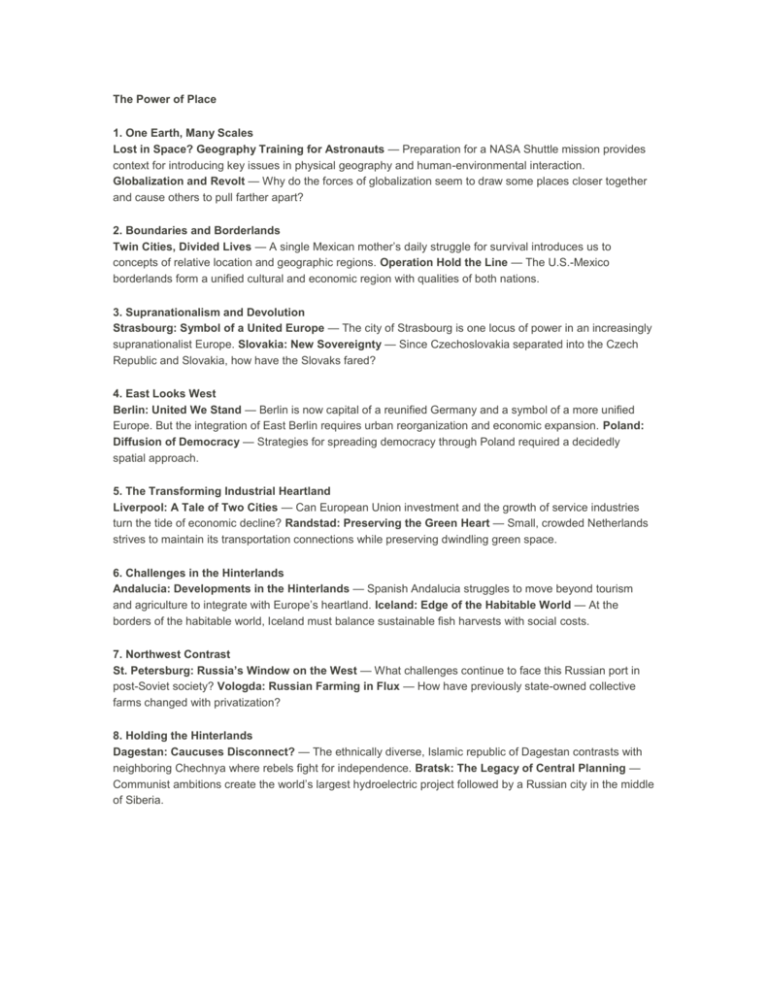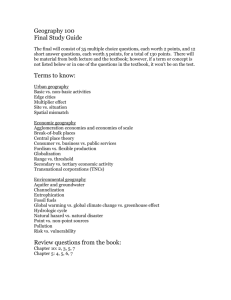here - Crescent School
advertisement

The Power of Place 1. One Earth, Many Scales Lost in Space? Geography Training for Astronauts — Preparation for a NASA Shuttle mission provides context for introducing key issues in physical geography and human-environmental interaction. Globalization and Revolt — Why do the forces of globalization seem to draw some places closer together and cause others to pull farther apart? 2. Boundaries and Borderlands Twin Cities, Divided Lives — A single Mexican mother’s daily struggle for survival introduces us to concepts of relative location and geographic regions. Operation Hold the Line — The U.S.-Mexico borderlands form a unified cultural and economic region with qualities of both nations. 3. Supranationalism and Devolution Strasbourg: Symbol of a United Europe — The city of Strasbourg is one locus of power in an increasingly supranationalist Europe. Slovakia: New Sovereignty — Since Czechoslovakia separated into the Czech Republic and Slovakia, how have the Slovaks fared? 4. East Looks West Berlin: United We Stand — Berlin is now capital of a reunified Germany and a symbol of a more unified Europe. But the integration of East Berlin requires urban reorganization and economic expansion. Poland: Diffusion of Democracy — Strategies for spreading democracy through Poland required a decidedly spatial approach. 5. The Transforming Industrial Heartland Liverpool: A Tale of Two Cities — Can European Union investment and the growth of service industries turn the tide of economic decline? Randstad: Preserving the Green Heart — Small, crowded Netherlands strives to maintain its transportation connections while preserving dwindling green space. 6. Challenges in the Hinterlands Andalucia: Developments in the Hinterlands — Spanish Andalucia struggles to move beyond tourism and agriculture to integrate with Europe’s heartland. Iceland: Edge of the Habitable World — At the borders of the habitable world, Iceland must balance sustainable fish harvests with social costs. 7. Northwest Contrast St. Petersburg: Russia’s Window on the West — What challenges continue to face this Russian port in post-Soviet society? Vologda: Russian Farming in Flux — How have previously state-owned collective farms changed with privatization? 8. Holding the Hinterlands Dagestan: Caucuses Disconnect? — The ethnically diverse, Islamic republic of Dagestan contrasts with neighboring Chechnya where rebels fight for independence. Bratsk: The Legacy of Central Planning — Communist ambitions create the world’s largest hydroelectric project followed by a Russian city in the middle of Siberia. 9. Changes on the Chang Jiang Shanghai: Head of the Dragon — Shanghai enters the 21st century on a wave of development, ready to reclaim its legacy as China’s commercial center. Sijia: Small Town, Big Change — The steady growth of a township enterprise illustrates three great contrasts in modern China: rural vs. urban, agricultural vs. industrial, coastal vs. interior. 10. The Booming Maritime Edge Guangdong: Globalization in the Pearl River Delta — This program explores globalization and the effects of modernization on Chinese society. Taiwan: High-Tech Tiger — What factors contributed to Taiwan’s emergence as a high-tech powerhouse? 11. A Challenge for Two Old Cities Lanzhou: Confluence of Cultures — We travel to the frontiers of Han and Muslim China in the city of Lanzhou. Shenyang: Hope for China’s Rust Belt? — A previously dynamic industrial city continues to struggle with modernizing its manufacturing infrastructure. 12. Small Farms, Big Cities Northern Japan: Protecting the Harvest — Japanese rice farmers battle destructive weather in order to save their crops. Tokyo: Anatomy of a Mega-City — The continuing expansion of the Tokyo megalopolis leads to ever-longer commutes and demand for suburban housing. 13. The Mainland Laos: Isolated Heart — Laos is emerging from isolation to join the global economy as an exporter of hydroelectric power. Vietnam: Fertile Dreams — As the world’s second largest rice exporter, Vietnam’s booming economy is evident in the explosive growth of Ho Chi Minh City. 14. The Maritime Connection Indonesia: Tourist Invasion — Their culture once imperiled by hordes of tourists, Balinese residents have developed strategies to profit from the tourist industry while maintaining cultural integrity. Multi-Cultural Malaysia — Amidst growing pressures from Islamic militants, social and economic programs seek to build tolerance among Malaysia’s diverse cultures. 15. Global Interaction Singapore: Gateway to Southeast Asia — High-tech infrastructure, a well-educated workforce and strict government repression have all helped Singapore become a pre-eminent port and one of the wealthiest cities in the world. Australia: New Links to Asia — Australia shifts its trade from Europe to the Asian “economic tigers.” 16. Urban and Rural Contrasts Delhi: Bursting at the Seams — The ever-expanding capital of India continues to act as a magnet, pulling millions of Indians away from the hardships of the rural countryside. Dikhatpura: Help Through Irrigation — In rural India, creating sustainable agricultural development proves a challenging proposition. 17. Sacred Space, Secular States? Jerusalem: Capital of Two States? — Can the historical and political geography of this holy city provide clues to a peaceful resolution between Jews and Palestinians? Turkey: Fundamental Change — At the edge of Europe, Turkey hopes to take economic advantage of its proximity to the western world. 18. Oil and Water Egypt: Gift of the Nile — This program investigates Egypt's limited natural resources, focusing on that nation's dependence on the Nile River. Oman: Looking Beyond Oil — Having benefited greatly from its relatively modest oil reserves, Oman looks to diversify its economy for future growth. 19. Strength To Overcome South Africa: This Land Is My Land — South Africa continues to face many challenges in redressing the land inequities under apartheid. Kenya: Medical Geography — AIDS has become one of the biggest killers in Kenya. How can geography help understand disease? 20. Developing Countries Cote d’Ivoire: Cocoa and Change — Cote d’Ivoire has long been the world’s largest producer of cocoa, but has recently faced economic downturns and loss of its historically stable government. Gabon: Sustainable Resources? — In one of Africa's wealthiest countries, oil revenues have declined, putting new pressure on the country's timber resources. 21. Population Geography Mexico: Motive To Migrate — A geographer's research reveals a major source of Mexican migration: the North-Central “Hollow Core.” Guatemala: Population and Conquest — Every year a greater number of Maya Indian victims of “continuing conquest” must share inadequate agricultural resources. 22. Dynamic Pacific Rim Ecuador: Orange Alert — When scientists monitoring the Tungurahua Volcano see dangerous signs, they have to advise the government: evacuate or remain? Chile: Pacific Rim Player — Bordered to the east by the towering Andes Mountains and to the west by the Pacific Ocean, Chile enjoys continued economic growth. 23. Brazil: The Sleeping Giant Sao Paulo: The Outer Ring — The sprawling mega-city of Sao Paulo is evidence that Latin America is among the most rapidly urbanizing regions. A Second Chance for Amazonia? — An American scientist discovers new possibilities for sustainable development in the Amazon basin. 24. Cityscapes, Suburban Sprawl Boston: Ethnic Mosaic — How has federal empowerment zone funding helped Boston's diverse but poor neighborhoods? Chicago: Farming on the Edge — As in many areas of the U.S., suburban Chicago just keeps expanding into the surrounding countryside. 25. Ethnic Fragmentation in Canada Vancouver: Hong Kong East — Prior to the Chinese takeover of Hong Kong, thousands of wealthy businessmen moved their families to Vancouver, causing a collision of cultures. What has happened since 1997? Montreal: An Island of French — Trying to preserve their culture, Quebec welcomes immigrants and pays to teach them French. 26. Regions and Economies Oregon: A Fight for Water — Native Americans and farmers compete for a scarce resource: water. U.S. Midwest: Spatial Innovations — In the U.S. Midwest, an influx of Japanese automakers has brought more than just new factories to this once-declining manufacturing region.










